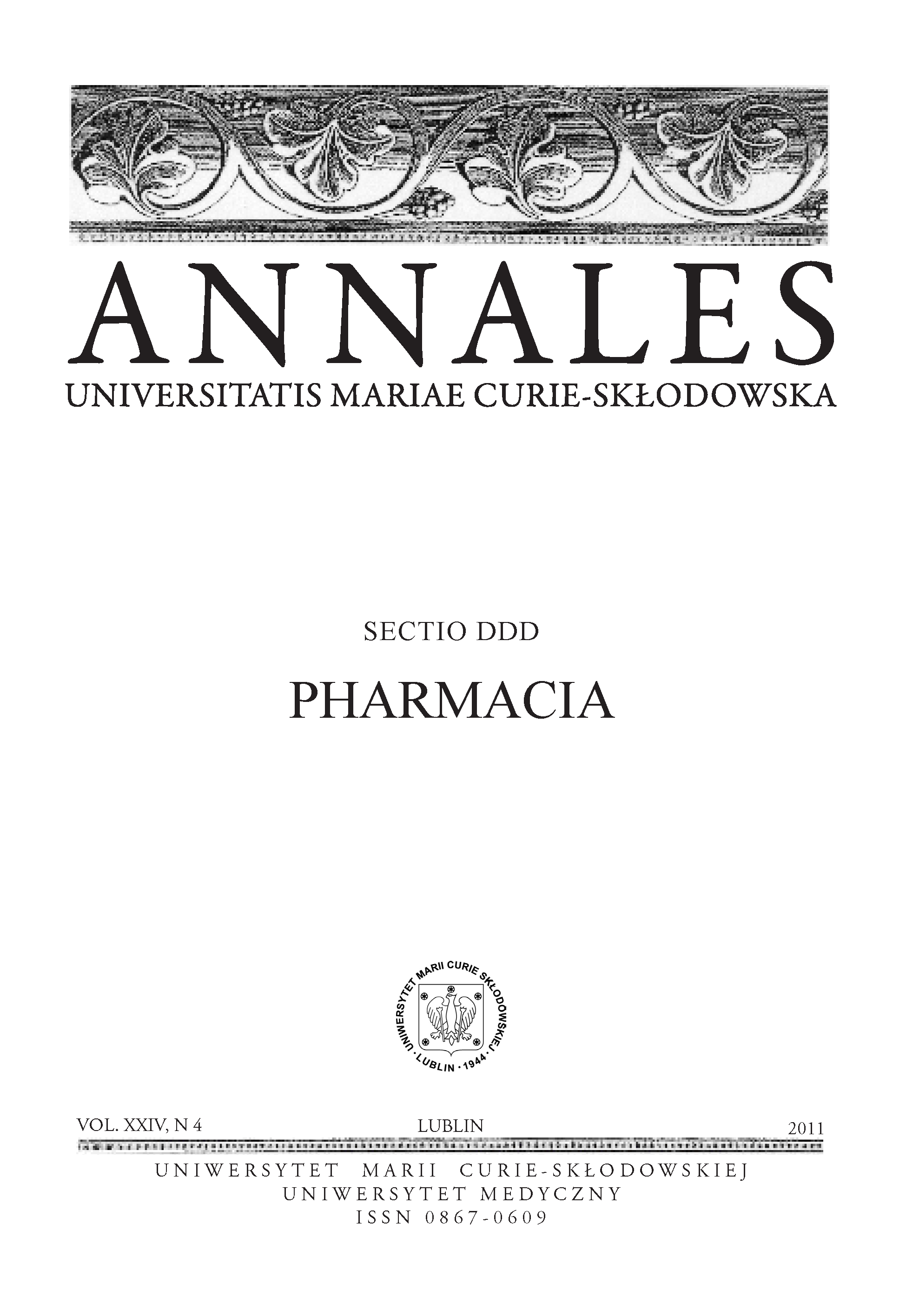Analiza zawartości kwasów fenolowych występujących w hyzopie lekarskim przy użyciu HPLC-DAD z kolumną monolityczną ChromolithTM RP-18e
DOI:
https://doi.org/10.12923/Słowa kluczowe:
Chromolith, ChromSword, HPLC, hyzop lekarski, Hyssopus officinalis L., kwasy fenoloweAbstrakt
W prezentowanej pracy przedstawiono optymalizację rozdziału chromatograficznego kwasów fenolowych przy zastosowaniu oprogramowania komputeriwego ChromSword®. Zastosowano gradient fazy mobilnej woda, acetonitryl, kwas octowy. Symulacja komputerowa rozdziału kwasów fenolowych wykazała wysoką korelacje liniową od 99,1 do 99,9%. Użycie kolumny monolitycznej pozwoliło na skrócenie czasu rozdziału kwasów fenolowych do 6 minut, przy niskim limicie detekcji 1,9 do 7,9 mg/L. W ekstrakcie z hyzopu lekarskiego zidentyfikowano następujące kwasy fenolowe: protokatechowy, gentyzynowy, chlorogenowy, ferulowy, galusowy i rozmarynowy.
Bibliografia
1. Apers S., Naessens T., Steen K. et al.: Fast high-performance liquid chromatography method for quality control of soy extracts. J. Chromatogr. A 1038, 107, 2004.
2. Beinert W.D., Eckert V., Galushko S. et al.: A program for automated HPLC method development. Am Lab. 33, 14, 2001.
3. Dzido T.H., Polak B., Wojcińska M., Gołkiewicz W.: Computer simulation of phenolic acids separation in reversed-phase high performance liquid chromatography. Chem. Anal. 45, 353, 2000.
4. Korner A., Kohn S.: Development and optimization of a stability indicating method on a monolithic reversed-phase column for Colchicum dry extract. J. Chromatogr. A, 1089, 148, 2005.
5. Krizman M., Baricevic D., Prosek M.: Determination of phenolic compounds in fennel by HPLC and HPLC–MS using a monolithic reversed-phase column. J. Pharm. Biomed. Anal. 43, 481, 2007.
6. Maruska A., Kornysova O.: Application of monolithic (continuous bed) chromatographic columns in phytochemical analysis. J. Chromatogr. A 1112, 319, 2006.
7. Petersen M., Simmonds M.S.J.: Molecules of interest: Rosmarinic acid. Phytochemistry 62, 121, 2002.
8. Rostagno M.A., Palma M., Barroso C.G.: Fast analysis of soy isoflavones by high-performance liquid chromatography with monolithic columns. Anal. Chim. Acta 582, 243, 2007.
9. Sanbongi C., Takano H., Osakabe N. et al.: Rosmarinic acid in perilla extract inhibits allergic inflammation induced by mite allergen, in a mouse model. Clin. Exp. Allergy 34, 971, 2004.
10. Santos-Gomes P.C., Seabra R.M., Andrade P.B., Ferreira M.F.: Determination of phenolic antioxidant compounds produced by calli and cell suspensions of sage (Salvia officinalis L.). J. Plant Physiol. 160, 1025, 2003.
11. Schmidt A.H.: Fast HPLC for quality control of Harpagophytum procumbens by using a monolithic silica column: method transfer from conventional particle-based silica column. J. Chromatogr.. A 1073, 377, 2005.
12. Ticli F.K., Hage L.I.S. Cambraia R.S. et al.: Rosmarinic acid, a new snake venom phospholipase A2 inhibitor from Cordia verbenacea (Boraginaceae): antiserum action potentiation and molecular interaction. Toxicon 46, 318, 2005.
13. Vian M.A., Tomao V., Gallet S. et al.: Simple and rapid method for cis- and trans-resveratrol and piceid isomers determination in wine by high-performance liquid chromatography using Chromolith columns. J. Chromatogr.. A, 1085, 224, 2005.
14. Wang H., Provan Gordon J., Helliwell K.: Determination of rosmarinic acid and caffeic acid in aromatic herbs by HPLC. Food Chem. 87, 307, 2004.
15. Yagasaki K., Miura Y., Okauchi R., Furuse T.: Inhibitory effects of chlorogenic acid and its related compounds on the invasion of hepatoma cells in culture. Cytotechnology 33, 229, 2000.
16. Zgórka G., Głowniak K.: Variation of free phenolic acids in medicinal plants belonging to the Lamiaceae family. J. Pharm. Biomed. Anal. 26, 79, 2001.
Pobrania
Opublikowane
Numer
Dział
Licencja
Prawa autorskie (c) 2025 Tomasz Baj, Anna Błażewicz, Łukasz Świątek, Tadeusz Wolski, Ryszard Kocjan, Kazimierz Głowniak (Autor)

Praca jest udostępniana na licencji Creative Commons Attribution-NonCommercial-NoDerivatives 3.0 Unported License.


